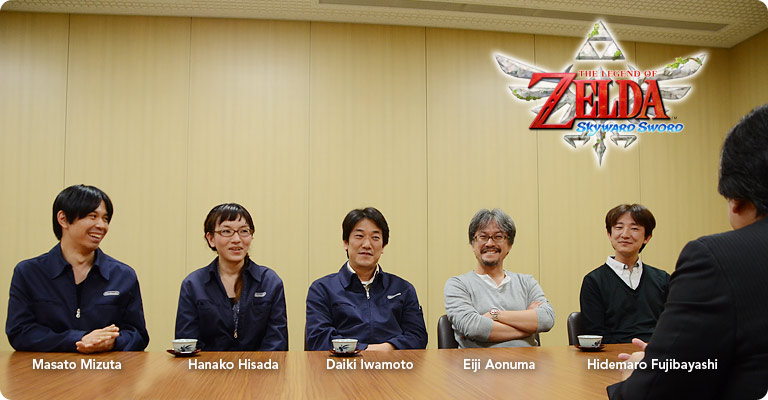Zelda: Skyward Sword details from the latest Iwata Asks
Posted on November 10, 2011 by Brian(@NE_Brian) in News, Wii
The fifth volume of the Iwata Asks interviews featuring Zelda: Skyward Sword has gone live. This time, the discussion focuses on the game’s sky/Skyloft. The information comes from Masato Mizuta, Hanako Hisada, Daiki Iwamoto, Eiji Aonuma, Hidemaro Fujibayashi, and Satoru Iwata.
– 10 people worked on sound
– Fiveworked on sound effects, five were composers
– Hajime Wakai pulled together the overall sound for the game
– Sound staff gradully grew as the team got a sense for the number of stages/scale of events
– Final sound effects staffer came in this year
– Game developed in-hose at Nintendo has never had a sound staff of ten people before Skyward Sword
– 22 designers for the landforms (most ever for Zelda and for a game made by Nintendo)
– Aonuma: “Usually, when we make a Legend of Zelda game with a continuous body of land, we need an overlapping part to join one game field to the next. This time, we made all kinds of gameplay for the forest, volcano and desert areas, and needed to create roads for going back and forth among those places. Every time, it was quite a struggle to figure out how to handle those roads.”
– Team thought they might not need “roads”
– Aonuma and Fujibayashi talked about how they wouldn’t need to physically join the areas if the gameplay was dense in each of them
– Aonuma thought of course selection in Mario games from this
– Couldn’t do course selection exactly the same way for Zelda
– Came up with the idea of having the starting location be floating in the sky
– Fujibayashi came up with the idea of Link jumping down to locations after watching something involving skydiving on TV
– For some time, there was the idea of jumping from a tower
– Land was a basin with a big tower standing in the center
– You would climb up to the tower and jump down
– The higher you climb, the further you can fly
– This was “pretty plain”, so they decided to jump down from the sky
– Aonuma wasn’t sure how the sky and the world below would relate to each other spatially
– Realized it would be impossible without some sort of transportation
– Iwamoto appointed the “gang leader” for the sky game field as Spirit Tracks development wrapped up
– Bird seemed like the most natural idea for transportation
– Iwamoto wanted to make sure you could fly anywhere you wanted
– After Skyloft came together somewhat, Aonuma took a looko at it from the beginning and wasn’t pleased with it
– Aonuma wasn’t getting a sense of drama that would unfold and wasn’t getting the feeling of excitement; also wasn’t clear whether the people who showed up were Link’s classmates
– Miyamoto is strict with game openings; if the beginning doesn’t grab players, he’ll say the game isn’t good
– Aonuma volunteered to be a planner
– Iwamoto couldn’t get around to the beginning because Skyloft had to be dense like the other game fields
– Special dev. tool used so planners could so numerous things
– Planners could take care of things such as character dialogue and timing of events to a certain extent
– What they would usually ask programmers to do could be done by themselves
– Miyamoto corrected a lot
– Sky originally functioned like a course selection screen; then turned into Skyloft and changed form into a hub for adventures
– Team wanted to make Skyloft a home base you come back to after accomplishing something; a place you stop by more than any other
– Item Check: shuffle around the contents of an Adventure Pouch
– Adventure Pouch: players think about what kind of Link they want to play when they head down to the surface for a particular adventure and make selections for the items in their pouch accordingly
– If you put in a bunch of medals in your pouch, lots of treasure will appear
– Multiple entrances for the Bazaar so you can access it anywhere; also at the center of Skyloft
– Shops put near each other so it’d be more convenient for the player
– Batreaux came about from designers’ opinions
– Batreaux: surviving member of a clan of demons, wants to become human
– If you grand Batreaux’s requests, he’ll give you different things
– So many subevents that there could have been a whole game based on them alone
– Mizuta payed special attention to the wind when making sounds for the game
– Work was divided up just for the wind
– Sword of the sound was also important
– Play the harp as you walk
– Can play the harp along with the background music
– Sound hurdle: tons of sounds to make
– Mario Club Co. Ltd recorded all the event scenes and the staff watched them, checking each one
– When Mizuta found events that didn’t have sounds, he listed to what music/sound effects were necessary
– Also used the recordings to see what sound didn’t fit
– Leader meetings help once a week; discussed development progress, picked up on all kinds of new info
– Contents of the game changed daily
– Aonuma believes they kept the project together, which was huge, because the game world is structurally simple
– A lot of effort put into the Loftwing so it would feel really good while you’re riding it
– Programmers/designers applied themselves to the precise movement of the wings, the feeling of soaring through the air, and the feeling of buoyancy
